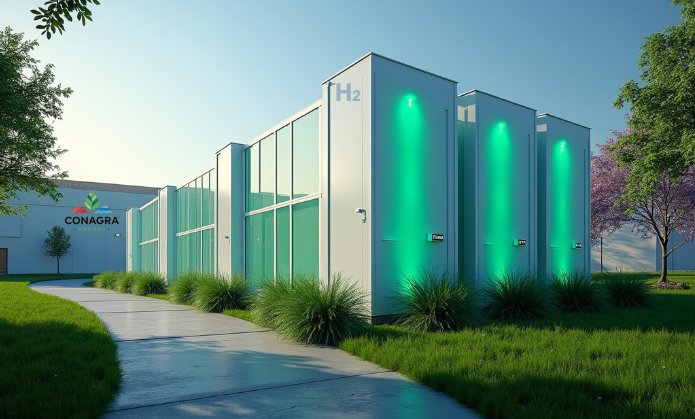
Conagra Brands & Bloom Energy Partner To Bring Revolutionary Solid Oxide Fuel Cell Technology To The Clean Energy Market
April 3, 2025In Early 2024, Conagra Brands and Bloom Energy launched an unprecedented partnership to install state-of-the-art solid oxide fuel cell (SOFC) technology at its Findlay, Ohio food facilities. The decision is aimed at increasing the production of green energy and reducing carbon emissions while relieving pressure on existing electricity transmission systems. Conagra, by wielding a cleaner on-site power source like that proposed to run Conagra’s plant in Missouri—where Steve Myers (MBA ’15) is engineering manager preparing the facility for completion soon—is poised at the tip of an array of advancements likely overshadowing KFCs new hydrogen fuel cells fleetWhile Toyota’s putting big money behind Helen Peters pointed her focus next dayCell grown batteries may supersede solar panelsToyota spinning as fast they can invested heavilyNew Crowder comes just days Panasonic and Tesla vowed to eliminate battery dependency entirely all hint towards zero-emissions future Obvious, perhaps.
The drive is launched amidst global corporations gearing up to adopt new technologies that enable them to become durable, green and economically viable. With the dual imperatives to cut operational costs for economic reasons and comply with stricter environmental standards that reduce levels of pollution related to energy production, this partnership is a testament as an example in cross-industry collaboration efforts added into business strategies, demonstrating ways industries would benefit from enhancing sustainable transportation solutions along integrated renewable power generation approaches.
What is this project about:
Conagra Brands is a North American food powerhouse with roots that go back to 1919, while Bloom Energy is based in San Jose and has been on the cutting edge of fuel cell technology. Conagra aims to focus its investment across different growth areas after diversifying through continuing decades of innovation that have most recently included: frozen meals, snacks and sustainable packaging; while Bloom Energy continues to drive SOCF for clean energy with standardized systems optimized by fuel type (natural gas/biogas/hydrogen/blends).
The core of the project centers on Bloom Energy installing its SOFC technology at Conagra’s Findlay, Ohio-based facility in an area long characterized by agricultural vibrancy and a strong manufacturing appetite. However, as the technology isn’t actually combustion and instead works through an electrochemical process, nearly nil noxious fumes are released. This time, however, the cells are being run on natural gas; and by switching to hydrogen it opens up potential development paths toward even lower-carbon or zero emission technologies. This reflects a larger trend in the work being done by forward-thinking companies like Toyota, which has been at the forefront of hydrogen fuel cell and sustainable energy production technologies.
A bit of Background
This effort is NOT taking place in vacuum! In recent years, this global surge has been heating up — prompted by climate change fears on one end and stressed traditional energy infrastructures to another. The onset of climate policies and expectation standards for consumers have forced major corporations to reconsider the modus operandi by incorporating environmental best practices.
Fuel cell technology has been around for over a century, but it wasn’t until recent materials science and manufacturing breakthroughs that these systems have become viable commercially. Bloom Energy’s SOFC technology not only is great to the environment, but also provides a secure and stable power source which practically food production facilities need while can´t be professionally interrupted.
Some similar projects
This same transition is happening around the world. For instance, efforts in Asia are combining hydrogen fuel cells and renewables to help move the region away from fossil fuels (Fig. 3). There are these projects and then elsewhere which demonstrates the overall global trajectory towards accepting leading edge, clean energy technologies. Like the decades of Toyota investing in hydrogen and sustainable transportation to effect improvements globally, so too is Conagra-Bloom Energy part of a global industrial greenerization movement.
Looking Ahead
The arrival of fuel cells at Conagra’s Findlay facility will lower, but not eliminate the operational exposure to grid dependence. Immediate benefits: Lower carbon emissions, possible government incentives and cost savings due to increased energy efficiency. With the volatility surrounding energy costs this is a competitive advantage.
Further still, the cascading wake of this project may be transformative. Conagra Brands, with the successful implementation of Bloom Energy’s cutting-edge power systems scores points among environmentally driven investors and ESG (Environment, Social, Governance) advocates. In turn, this would help to establish a blueprint for success such that companies in the food industry and beyond could more widely adopt hydrogen fuel cells as well as other renewable options.
Discoveries made from such an initiative could entice even more investment in clean energy on a larger world stage. With even bigger players in the industry such as Toyota advocating for new ways to move and furthering their technology through solutions like Toyota hydrogen, there is a huge potential for cooperation among research institutions all over the world aiming at increasing efficiencies with innovations that lessen reliance on fossil fuels making it more resilient and sustainable.
Some challenges and opportunities
Naturally, such a revolutionary project is never going to be unproblematic. The main hurdles to commercializing such technology at master scale are the investment and ensuring an economic reliable supply of fuel, be it natural gas or hydrogen as a flammable substance. Regulatory concerns also come into play, companies have to surmount a difficult technological and policy terrain in order to put these solutions effectively.
Nonetheless, these challenges are counterbalanced by extensive opportunities. While regulators and corporate leaders work to decarbonize the economy, companies that invest in hydrogen fuel cells or other technologies meant to pave a greener path could find bipartisan support — even if it ultimately means spending more money. There will also be various ripple effects, from new jobs (especially in places like Findlay Ohio) to spin-off industries related to wind installations and maintenance as well as the next round of tech innovation.
The future landscape
The road ahead This announcement of the partnership between Conagra and Bloom Energy is a shining example for what we can expect in this clean energy space. This shows that the economic and environmental advantages of hybridizing traditional industrial operations with more advanced energy systems are not only possible but arrogant. This is a project that any energy wonks–or just fans of wild, sci-fi transportation innovation like zero-emission technology and sustainable transport—should keep an eye on. They might provide a model for comparable efforts in many sectors around the world.
In short, this groundbreaking collaboration illustrates the desperate requirement for a revamp in how we create electricity. For industry leaders like Conagra and Bloom Energy, by focusing on resiliency coupled with sustainability and cost containment—with the added bonus that clean energy has become familiar—they are no longer responding to today’s unique circumstances but instead paving a path for our future. As we can see from this, it’s a pretty exciting time for hydrogen fuel cells and this is just the beginning.
About Conagra Brands:Conagra Brands, Inc. (NYSE:CAG), headquartered in Chicago, is one of North America`s leading branded food companies. The company is committed to progress, growing as one of the biggest companies in food and working towards a more sustainable future with green practices and clean energy solutions.



 With over 15 years of reporting hydrogen news, we are your premier source for the latest updates and insights in hydrogen and renewable energy.
With over 15 years of reporting hydrogen news, we are your premier source for the latest updates and insights in hydrogen and renewable energy.